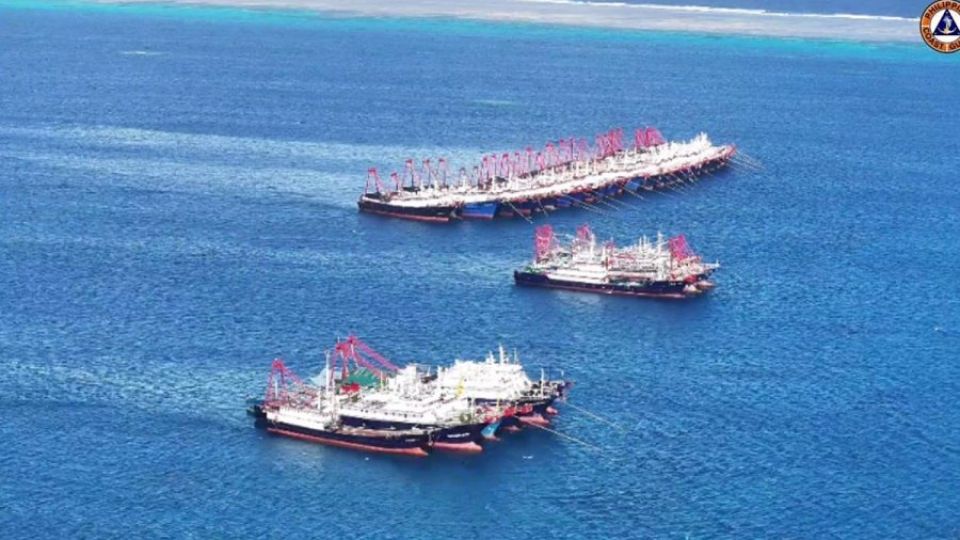September 11, 2024
MANILA – The number of Chinese ships monitored last week in the West Philippine Sea (WPS) went up to 207, the highest so far this year, particularly in Escoda (Sabina) Shoal, the new flashpoint in the simmering maritime dispute between Manila and Beijing in the South China Sea.
Data from the Armed Forces of the Philippines on Tuesday showed that in Escoda alone, there were at least 68 Chinese ships from Sept. 3 to Sept. 9, composed of eight from the China Coast Guard (CCG), five China warships and 55 Chinese maritime militia ships.
There were 203 Chinese vessels monitored by the AFP in WPS from Aug. 27 to Sept. 2.
According to Rear Adm. Roy Vincent Trinidad, the Philippine Navy spokesperson for WPS, “a lot of the maritime militia are focused on Escoda” since the Philippine Coast Guard (PCG) deployed one of its vessels, BRP Teresa Magbanua, to the shoal in April in response to the reported presence there of Chinese maritime militias and reclamation activities.
“Sabina or Escoda has been under our attention for the past good number of months because of the reported increase of crushed corals and we have to determine if this is manmade or by force of nature,” Trinidad said in a press briefing at Camp Aguinaldo in Quezon City.
Illegal presence
“In the first place, even with only one ship, their [Chinese vessels] presence is already illegal within the [Philippines’] exclusive economic zone. It just so happened that because of our extra attention given to Sabina Shoal, the maritime militia numbers have also increased [in the area],” he added.
The PCG, Trinidad stressed, would continue to have a “sustained presence” at Escoda even after a CCG vessel intentionally hit and damaged BRP Teresa Magbanua on Aug. 31.
Despite the ramming, the PCG ship remains seaworthy, he said, adding that “whatever damage has been incurred will not compromise [its] overall integrity, water integrity. Hence, it is still there performing its mission.”
Trinidad further said the AFP and PCG would continue their resupply missions to Escoda and would not be “deterred by any action from any adversary.”
Chinese ships have blocked Philippine vessels from bringing fresh supplies to BRP Teresa Magbanua, prompting the military to airdrop the items instead.
To prevent Chinese ships from harassing the resupply ships, House Deputy Majority Leader Erwin Tulfo asked his colleagues to endorse, as a “preventive measure,” the United States’ offer to provide them escort in the WPS.
In a privilege speech in Monday’s plenary session, the ACT-CIS party representative cited US Indo-Pacific Command chief Adm. Samuel Paparo Jr.’s statement that their ships could serve as escorts in resupply operations, particularly for the BRP Sierra Madre in Ayungin (Second Thomas) Shoal.
“This proposal is not merely a matter of convenience. It is a significant step in asserting our rights under international law and challenging the persistent encroachments by [China],” Tulfo said.
Ayungin used to be the flashpoint for encounters between the Philippines and China, with the latter’s ships frequently harassing Filipino resupply vessels en route to BRP Sierra Madre. In one of the most violent incidents, a Filipino sailor lost a thumb.
Extra attention
Aside from Escoda, the AFP has also monitored a Chinese warship and 58 Chinese maritime militia ships at Iroquois (Rozul) Reef.
“We are still trying to assess why there is an increase in number in Iroquois or Rozul reef. We could state that for Sabina or Escoda, it’s because of the extra attention that we have given to that particular shore. For Iroquois or Rozul we are still trying to assess,” Trinidad said.
Rozul, which is located in the southernmost part of the gas and oil-rich Recto (Reed) Bank, is about 237 kilometers northwest of Palawan province.
The AFP also spotted 12 Chinese maritime militia ships and one CCG vessel at Panatag (Scarborough) Shoal while 49 militia vessels and a CCG vessel were seen at Pag-asa Island.
In Ayungin, the military monitored eight CCG vessels and two militia ships. A Chinese research vessel was also seen at Rizal Reef while the other militia ships were monitored in likas, Panata, and Lawak Islands.
On Tuesday, US maritime expert Ray Powell said Chinese hydrographic research ship Haiyang Dizhi 12 Hao and six Qiong Sansha Yu maritime militia ships were spotted near Recto Bank.
Powell, the director of SeaLight, a program of Stanford University’s Gordian Knot Center for National Security Innovation that tracks Chinese activities in WPS, said China “employs escorts when it sends its survey ships into highly contested waters.”


